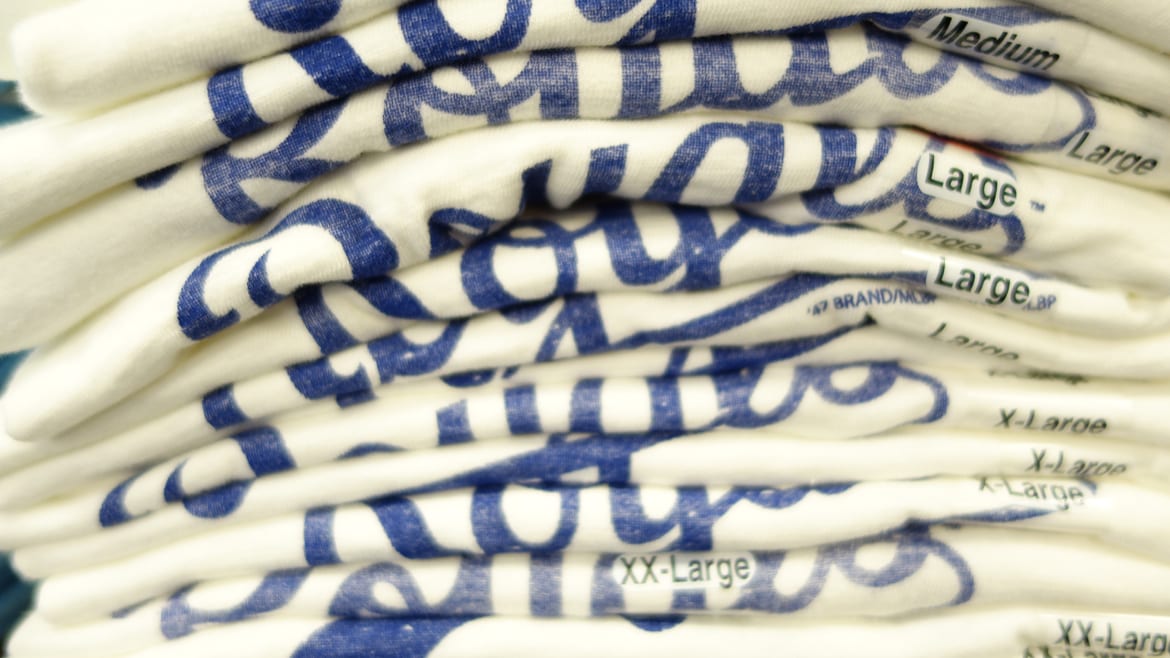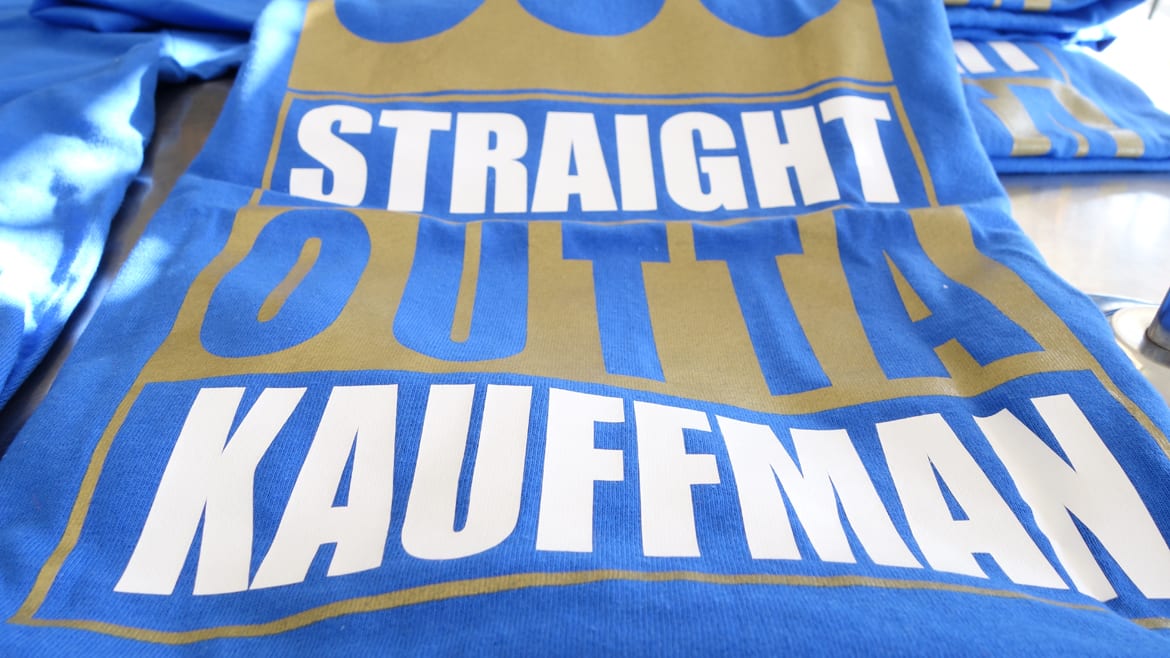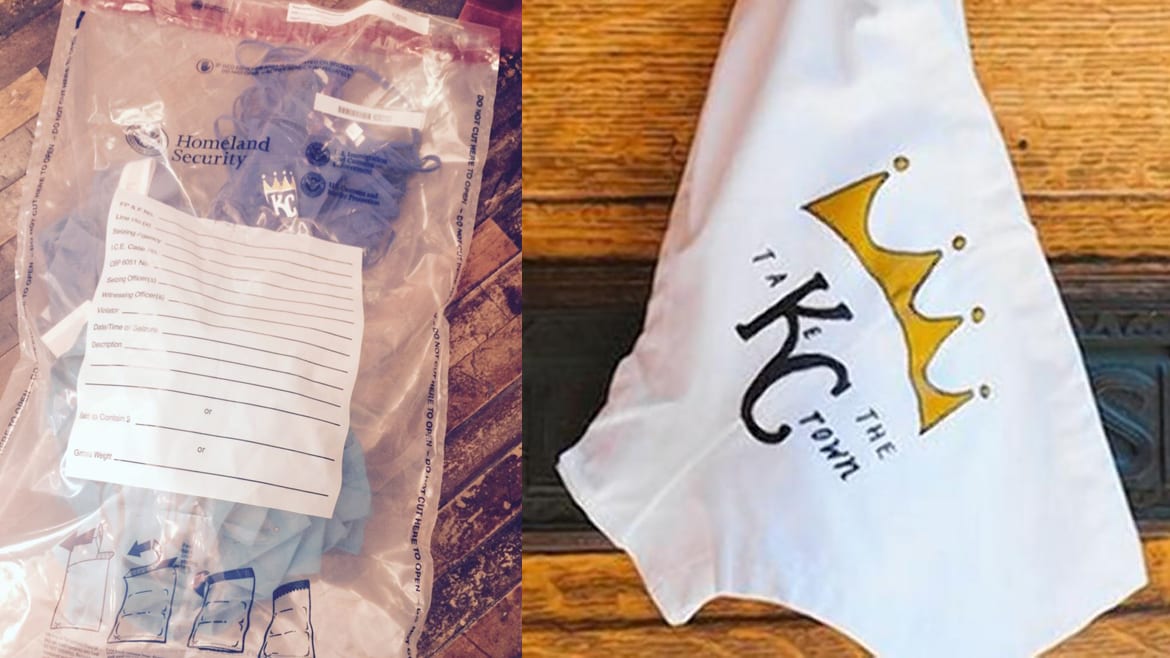What’s in a Trademark? Law. Lots and Lots of Law. Maybe you snagged a generic "World Champs" shirt after the Series. Or your Chiefs red is more off-pink. Is it a big deal?
 While the Kansas City Royals owns its most-recognizable lettering and slogans, it's the MLB that enforces any trademark violations. (Photo: Dan Calderon | Flatland)
While the Kansas City Royals owns its most-recognizable lettering and slogans, it's the MLB that enforces any trademark violations. (Photo: Dan Calderon | Flatland)
Published December 28th, 2015 at 7:55 AM
In 2014, while stuck in Kansas City rush hour traffic listening to N.W.A.’s infamous track, “Straight Outta Compton,” Mattie Green had a great idea. Why not replace “Compton” with “Kauffman” – a reference to the Kansas City Royals’ home field?
In March 2014, Green had a single T-shirt printed with the phrase and a photo of Kauffman Stadium. She began wearing the shirt out in public and immediately received demands from friends who wanted their own. Eventually, her close friend, sports podcaster Gracey Terrill, convinced Green to mass produce the shirts and sell them, and the two partnered up on the venture.
The shirts were first marketed and sold in October 2014. But sales really took off in April 2015 when, after a rash of on-field spats and bench-clearing brawls, the Royals were anointed the bad boys of Major League Baseball. This reputation, it seems, captured the spirit of the shirts Terrill and Green were making. As a result, sales began to rise and other shirt makers began creating similar, competing shirts. To protect their idea, Terrill and Green applied for a trademark for the phrase “Straight Outta Kauffman”.
The shirts continued to sell through the 2015 season without issue until this fall, when Major League Baseball contacted Terrill with a cease and desist letter.
“We were just doing our own thing,” Terrill said. “And I know that the type of shirts we were doing had a likeness to the Royals, so that’s why I think they were having issues with it. But when I got a cease and desist from [Major League Baseball], that’s when I realized that this was pretty serious.”
Terrill’s case is not uncommon. Street tents and store displays selling World Series apparel have been prevalent throughout the Kansas City area following the Royals’ championship run. And with the Chiefs doing well and college hoops starting in earnest, the area is likely to see an uptick in retailers selling potentially infringing sports apparel. Some may fly under the radar, but others will face a similar fate to Terrill’s or, worse, be forced to surrender products and close down shop for fear of litigation.
This has led to some confusion about what a trademark is, how the law is enforced, and how trademark protections affect individual consumers like you and me.
As it turns out, trademark infringement is somewhat of a nebulous concept, lacking any sort of bright line to separate willful infringers from innocent entrepreneurs, and relies heavily on subjective analysis when determining whether infringement has occurred.
To the United States Patent and Trade Office, a trademark is “a word, phrase, symbol, or design, or a combination thereof, that identifies and distinguishes the source of the goods of one party from those of others”. In the real world, trademarks are typically protected names, slogans, and logos.
The Kansas City Royals Baseball Corporation has trademarked more than 50 separate entries, ranging from words like “Royals” and “Kauffman Stadium” to the many variations of its logos, including the overlapping “KC” letters used on ball caps and other licensed Royals apparel.
But while these trademarks are owned by the Royals, they are typically policed by MLB, thanks to an agreement that grants MLB the right to handle licensing for all of its member teams and enforce trademarks on their behalf.
Generally, enforcement and protection of trademarks falls under two separate categories. There is civil enforcement – in which the private business or organization that holds the trademark takes action or files suit against the infringer. Then there is criminal enforcement – which involves, oddly enough, the Department of Homeland Security, which may confiscate counterfeit goods and establish a basis to prosecute infringers in federal court.
Civil Enforcement: Protecting Your Mark
If, like Terril, a potentially infringing seller is faced with the threat a civil suit, the seller could be subject to an order from a court to stop the infringing activity or be forced to surrender profits to the trademark holder. However, according to Thomas Busch, partner at Martin Pringle Law Firm, the protection of rights to the mark is the main goal of civil enforcement.
“The number one concern with policing your mark and trying to go after infringers is not the recovery of revenue. It’s the concern with actually losing your rights to your mark,” Busch said. “If there is a mark in use that is confusingly similar to yours or diluting the value of your mark, then you want to eliminate it from being used. Because at some point in time, you will lose the right to own the mark and enforce your exclusive use of the mark if you don’t.”
Busch’s practice at Martin Pringle includes serving as Director of Licensing for the Negro Leagues Museum since 1991. According to Busch, in order to prevail on a claim of trademark infringement, a party has to establish that it owns the mark and that it has priority of use.
And while the controlling factors for civil litigation vary greatly depending on the federal circuit in which a case is brought, the most common infringing products are those that either “confuse” consumers or “dilute” the trademark. The main difference between the two is that the concept of confusion is focused on protecting the consumer’s ability to distinguish goods, while dilution is focused more on allowing holders of famous marks to protect their brand.
Of the many marks registered by the Royals, for example, none include any design elements of the signature scoreboard crown or reference to the word “crown”, which has been the subject of some trademark disputes around the area. But according to Busch, that doesn’t preclude MLB from any enforcement action.
“[The Royals] haven’t separated out the design elements of the crown and filed a separate registration for it. But they don’t necessarily have to either,” Busch said. “If, by the virtue of the similarity of design and the combination of colors or whatever else is used on the goods, it’s pretty obvious that someone is trying to take advantage of the goodwill associated with the Kansas City Royals, then that’s probably an infringing use.”
MLB took the dilution stance in its letter to Terrill regarding the “Straight Outta Kauffman” shirts, arguing that because the Kansas City Royals and Kauffman Stadium are so famous, consumers would falsely presume that there is a connection between the organization and Terrill’s company, thereby diluting the marks of both MLB and the Royals.
Criminal Enforcement: Protecting Borders
Thankfully, the analysis for criminal trademark enforcement is much more straightforward.
Trademark law is enforced by The Department of Homeland Security, specifically Homeland Security Investigations, part of Immigration and Customs Enforcement. HSI polices more than 450 international statutes, including trademark enforcement, which is a subset of its intellectual property theft investigations.
Shawn Neudauer, Public Affairs Officer for the Department of Homeland Security, described HSI’s trademark targets as those “who are lifting something from one thing and using it inappropriately on another thing when they don’t have the right to do so.”
For instance, if a seller began making T-shirts containing the interlocking “KC” used on official Royals apparel, without first obtaining a license to do so, the seller would be subject to criminal enforcement.
HSI is notified of potential trademark infringement through a tip line and local partners, which is usually local law enforcement. Once receiving a tip, HSI investigates the seller and determines whether to pursue criminal penalties. Shawn Gibson, Supervisor Special Agent for HSI’s Kansas City office, who oversees intellectual property rights enforcement, said HSI attempts to educate sellers before taking action.
“We understand that there is some confusion in the law,” Gibson said. “The statute on both sides requires that we prove [the seller had] knowledge that they were doing it. But we also try to educate them so that if they are in the dark and they don’t understand it, we give them a chance to know exactly what it is they’re violating.”
During the postseason in Kansas City, HSI visited many local shops and tents to ensure the products being sold were compliant with both local and federal laws.
“For a lot of the tents that were popping up during the postseason and the World Series, we took a multiple prong approach,” Gibson said. ‘We would go out to the tents to make sure they weren’t selling any trademarked merchandise. We also would make sure that they had a business license and were doing everything on the up and up. Many of the tents complied with what we requested and they were allowed to sell their items.”
The sellers who continue to push counterfeit goods, despite being notified of their infringement, are subject to criminal penalties, which can include seizure of the counterfeit apparel, statutory fines, and imprisonment up to five years, depending upon the scope of the activity.
Gibson said HSI had seized apparel valuing between $250,000-300,0000 in Kansas City during the Royals’ 2015 postseason run alone. This included both Royals apparel and counterfeit apparel relating to other professional sports leagues like the NFL, NBA, and NHL.
Over the past two years, HSI was subjected to some scrutiny as a result of two well-publicized seizures. In 2014, Birdies Panties of Kansas City was forced to surrender a few dozen pairs of women’s underwear that displayed a crown, the words “Take the Crown”, and a version of the interlocking “KC”. And this year, Sportswear Etc. in Overland Park had around $100,000 in counterfeit postseason apparel seized.
Neudauer said in both cases HSI was the target of public outcry questioning why it and Homeland Security use tax dollars to protect trademarks owned by big corporations. In response, Neudauer pointed to Homeland Security’s jurisdiction over the applicable laws, its aim to protect the country as a whole, and its dedication to keeping unregulated, potentially harmful apparel from creeping into local commerce.
“That’s our job. We’re supposed to be enforcing immigration laws, customs laws, and financial laws. And by doing so it makes our economy more secure, public safety more secure, and the borders more secure.” Neudauer said.
For Homeland Security, local apparel sales and trademark infringement are only part of the battle. It also polices the U.S. borders and ports to combat the much larger problem of counterfeit apparel being imported from places like China and Hong Kong. The hope there is to prevent these goods from getting into to the stream of commerce and to “protect the supply chain,” as Neudauer explained.
And For the Rest of Us?
These instances of trademark enforcement throughout the Kansas City area over the past two years have begged the question of why trademark holders and HSI would go to such lengths to protect these marks. For trademark holders, enforcement is a means of protecting their rights to their marks and their brand image.
For instance, while MLB is clearly motivated by establishing visible boundaries between its licensed apparel and infringing or counterfeit products, it is also dedicated to maintaining the public’s trust in the quality of officially licensed goods. Those guidelines include tough quality control systems that ensure that MLB can stand behind any product containing its marks.
For HSI, enforcement is about protecting domestic commerce, American jobs, and ultimately – individual consumers. According to Gilbert Trill, Assistant Special Agent in Charge for Kansas City’s HSI office, counterfeiters can frequently circumvent regulations on consumer products that are intended to protect individuals.
“We had a case last year where we seized some jerseys and after we had them in evidence for a while, they started turning green,” Trill said. “When you’re trafficking in illegitimate or counterfeit goods, there’s no control on it. The dyes could be using lead or all kinds of other chemicals. You think you’re getting a great deal but you could be getting something that’s harmful to you.”
However harrowing that may sound, wearing potentially noxious chemicals is the only threat to the individual consumer buying the counterfeit materials. Enforcement is typically directed toward those who produce and sell counterfeit goods, not their purchasers.
So, if you happened to get a “Straight Outta Kauffman” T-shirt, a pair of “Take the Crown” panties, or some other unlicensed baseball apparel for the holidays, you can confidently wear your counterfeit or infringing goods in public.
Just don’t bother invoking the MLB apparel warranty policy if the seams start to split.
— Dan Calderon is a practicing attorney when he’s not writing his bi-monthly music column, Sympathetic Vibrations, for Flatland. Reach him at pdancalderon@gmail.com and on Twitter @dansascity.




